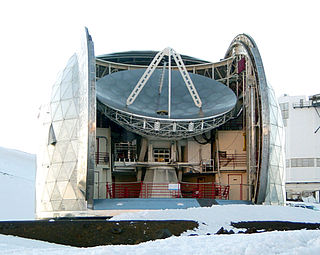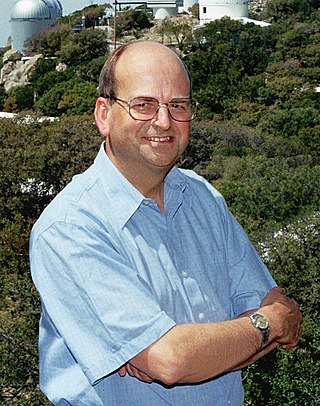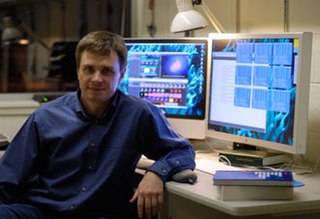
Sandra Moore Faber is an American astrophysicist known for her research on the evolution of galaxies. She is the University Professor of Astronomy and Astrophysics at the University of California, Santa Cruz, and works at the Lick Observatory. She has made discoveries linking the brightness of galaxies to the speed of stars within them and was the co-discoverer of the Faber–Jackson relation. Faber was also instrumental in designing the Keck telescopes in Hawaii.

The Center for Astrophysics | Harvard & Smithsonian (CfA), previously known as the Harvard–Smithsonian Center for Astrophysics, is an astrophysics research institute jointly operated by the Harvard College Observatory and Smithsonian Astrophysical Observatory. Founded in 1973 and headquartered in Cambridge, Massachusetts, United States, the CfA leads a broad program of research in astronomy, astrophysics, Earth and space sciences, as well as science education. The CfA either leads or participates in the development and operations of more than fifteen ground- and space-based astronomical research observatories across the electromagnetic spectrum, including the forthcoming Giant Magellan Telescope (GMT) and the Chandra X-ray Observatory, one of NASA's Great Observatories.

The Caltech Submillimeter Observatory (CSO) was a 10.4-meter (34 ft) diameter submillimeter wavelength telescope situated alongside the 15-meter (49 ft) James Clerk Maxwell Telescope (JCMT) at Mauna Kea Observatories. Beginning in 1986, it was engaged in submillimeter astronomy of the terahertz radiation band. The telescope closed on September 18, 2015.
The Combined Array for Research in Millimeter-wave Astronomy (CARMA) was an astronomical instrument comprising 23 radio telescopes, dedicated in 2006. These telescopes formed an astronomical interferometer where all the signals are combined in a purpose-built computer to produce high-resolution astronomical images. The telescopes ceased operation in April 2015 and were relocated to the Owens Valley Radio Observatory for storage.

James Edward Gunn is the Eugene Higgins Professor of Astronomy at Princeton University. Gunn's early theoretical work in astronomy has helped establish the current understanding of how galaxies form, and the properties of the space between galaxies. He also suggested important observational tests to confirm the presence of dark matter in galaxies, and predicted the existence of a Gunn–Peterson trough in the spectra of distant quasars.

Llano de Chajnantor Observatory is the name for a group of astronomical observatories located at an altitude of over 4,800 m (15,700 ft) in the Atacama Desert of northern Chile. The site is in the Antofagasta Region approximately 50 kilometres (31 mi) east of the town of San Pedro de Atacama. The exceptionally arid climate of the area is inhospitable to humans, but creates an excellent location for millimeter, submillimeter, and mid-infrared astronomy. This is because water vapour absorbs and attenuates submillimetre radiation. Llano de Chajnantor is home to the largest and most expensive astronomical telescope project in the world, the Atacama Large Millimeter Array (ALMA). Llano de Chajnantor and the surrounding area has been designated as the Chajnantor Science Reserve by the government of Chile.

Margaret J. Geller is an American astrophysicist at the Center for Astrophysics | Harvard & Smithsonian. Her work has included pioneering maps of the nearby universe, studies of the relationship between galaxies and their environment, and the development and application of methods for measuring the distribution of matter in the universe.

Robert P. Kirshner is an American astronomer, Chief Program Officer for Science for the Gordon and Betty Moore Foundation, and the Clownes Research Professor of Science at Harvard University. Kirshner has worked in several areas of astronomy including the physics of supernovae, supernova remnants, the large-scale structure of the cosmos, and the use of supernovae to measure the expansion of the universe.
The Gruber Prize in Cosmology, established in 2000, is one of three prestigious international awards worth US$500,000 awarded by the Gruber Foundation, a non-profit organization based at Yale University in New Haven, Connecticut.

Kenneth Charles Freeman is an Australian astronomer and astrophysicist who is currently Duffield Professor of Astronomy in the Research School of Astronomy and Astrophysics at the Mount Stromlo Observatory of the Australian National University in Canberra. He was born in Perth, Western Australia in 1940, studied mathematics and physics at the University of Western Australia, and graduated with first class honours in applied mathematics in 1962. He then went to Cambridge University for postgraduate work in theoretical astrophysics with Leon Mestel and Donald Lynden-Bell, and completed his doctorate in 1965. Following a postdoctoral appointment at the University of Texas with Gérard de Vaucouleurs, and a research fellowship at Trinity College, Cambridge, he returned to Australia in 1967 as a Queen Elizabeth Fellow at Mount Stromlo. Apart from a year in the Kapteyn Institute in Groningen in 1976 and some occasional absences overseas, he has been at Mount Stromlo ever since.
Brian J. Boyle is a Scottish astrophysicist based in Sydney, Australia from 1996 to 2019, and in Queenstown, New Zealand from 2020. His primary research interests are in the fields of quasars, active galaxies and cosmology.

Jeremy Richard Mould is an Australian astronomer currently at the Centre for Astrophysics and Supercomputing at Swinburne University of Technology. Mould was previously Director of the Research School of Astronomy and Astrophysics at the Australian National University and the American National Optical Astronomy Observatory. He is an Honorary Professorial Fellow, at the University of Melbourne.

The kinetic inductance detector (KID) — also known as a microwave kinetic inductance detector (MKID) — is a type of superconducting photon detector capable of counting single photons whilst simultaneously measuring their energy and arrival time to high precision. They were first developed by scientists at the California Institute of Technology and the Jet Propulsion Laboratory in 2003. These devices operate at cryogenic temperatures, typically below 1 kelvin. They are being developed for high-sensitivity astronomical detection for frequencies ranging from the far-infrared to X-rays.

Wendy Laurel Freedman is a Canadian-American astronomer, best known for her measurement of the Hubble constant, and as director of the Carnegie Observatories in Pasadena, California, and Las Campanas, Chile. She is now the John & Marion Sullivan University Professor of Astronomy and Astrophysics at the University of Chicago. Her principal research interests are in observational cosmology, focusing on measuring both the current and past expansion rates of the universe, and on characterizing the nature of dark energy.

Judith Lynn Pipher was a Canadian-born American astrophysicist and observational astronomer. She was Professor Emerita of Astronomy at the University of Rochester and directed the C. E. K. Mees Observatory from 1979 to 1994. She made important contributions to the development of infrared detector arrays in space telescopes.

The Academia Sinica Institute of Astronomy and Astrophysics is an affiliated research institute of Academia Sinica in Taipei.
Rachel Bean is a cosmologist, theoretical astrophysicist, professor of astronomy, and senior associate dean for math and science at the College of Arts and Sciences at Cornell University.

Violette Impellizzeri is an Italian astronomer and astrophysicist specializing in active galactic nuclei and molecular clouds surrounding supermassive black holes. She is currently a professor at Leiden University, where she conducts research on these phenomena using radio interferometry.
Giovanni Fazio is an American physicist at Center for Astrophysics | Harvard & Smithsonian. He is an astrophysicist who has initiated and participated in multiple observation programs.

Alexey Vikhlinin is a Russian-American astrophysicist notable for achievements in the astrophysics of high energy phenomenon, namely galaxy cluster cosmology and the design of space-based X-ray observatories. He is currently a senior astrophysicist at the Smithsonian Astrophysical Observatory, part of the Center for Astrophysics | Harvard & Smithsonian in Cambridge, Massachusetts. He was recently the Science and Technology Definition Team (STDT) Community Co-chair for the Lynx X-ray Observatory, a NASA-funded Large Mission Concept Study under consideration by the 2020 Decadal Survey on Astronomy and Astrophysics.














